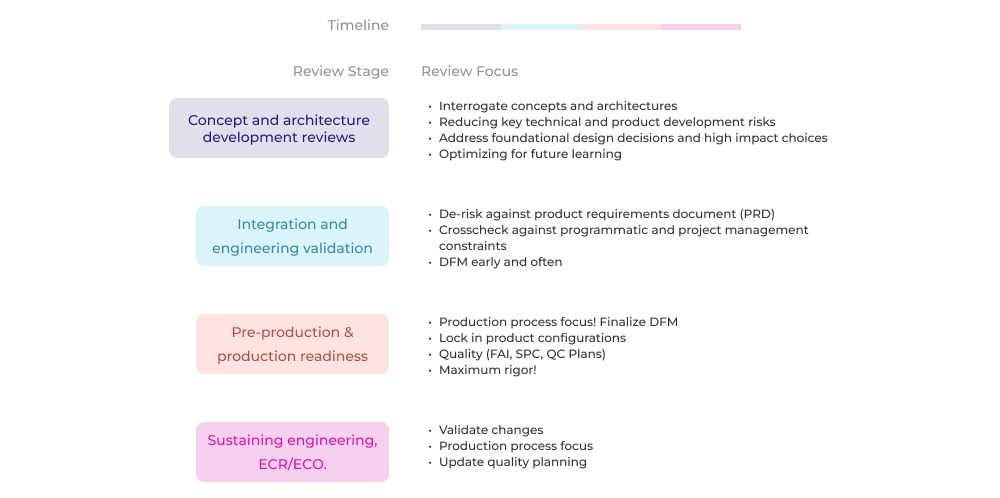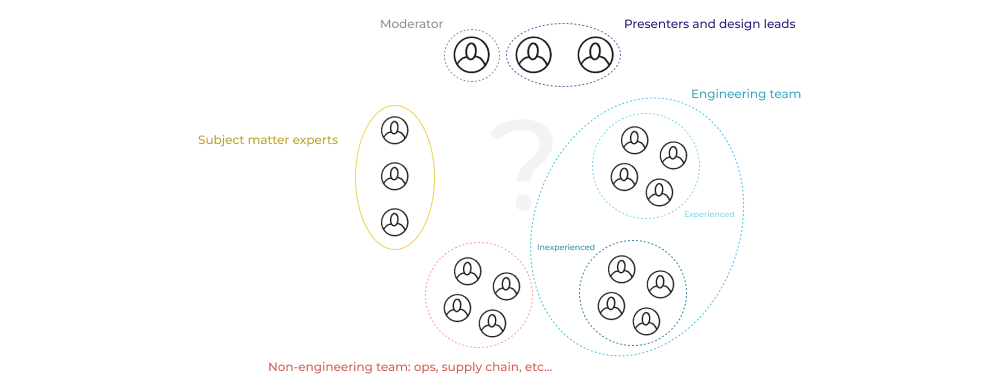Whether you put it on the calendar and give it a fancy name (super-critical design review!) or just gather around your coworker’s laptop, effective design reviews can come in many shapes and sizes, and that’s OK! There is no one size fits all review methodology. The important thing is to consider where you are in your development, and match your design review process accordingly. In this article we’re going to cover how to plan and prepare for an effective mechanical engineering design review, no matter what stage of product development you are currently working through.
Why design reviews?
Before we get into the how, there are a few important things to understand about design reviews that should motivate you and your team. The teams that consistently run effective design reviews tend to discover more issues with their designs earlier in the product development process. Discovering issues early ensures the team has maximum design freedom and minimal design inertia when tackling these issues. This translates into better design solutions in less time and at lower cost (plus happier engineers!)
Define your goals
This step is often omitted because engineers feel like everyone on the design team shares enough context already. Don’t skip this if you want to keep your reviews from going off the rails!
One of the best ways to get started is to ask yourself a few simple questions to get oriented. What is the point of this design review? What do I hope to get out of it? Are there aspects of the design that you are most worried about? What seems risky? What seems straightforward? Are there areas where you explicitly don’t want feedback because the work is incomplete?

Taking a few moments to answer these kinds of questions for yourself can help you prepare more efficiently, keep discussion on track, get more useful feedback, and improve your designs more efficiently.
PRACTICAL GUIDANCE
To get the most bang for your buck you should match your design review goals to the maturity of your current design. Start by thinking about where you are in your development timeline.

Then tailor your review objectives to the needs of each phase. Here’s an overview of what to consider at each stage in your development.
- Concept and architecture development. Before developing integrated engineering prototypes, you will be experimenting with different architectures, making breadboards, roadkill prototypes, and other partial assembly and subsystem prototypes. At this stage you should be focused on reducing technical and product development risks. Your reviews should address foundational design decisions and high impact choices that will set your team’s direction for subsequent iterations. Don’t worry about interrogating the design against a detailed list of functional requirements (you probably don’t have one yet anyway!). Instead focus on reducing key risks and optimizing for learning.
- Integration and engineering validation. When you start developing integrated engineering prototypes, you need to start reviewing against important requirements in a more rigorous manner. Outside of de-risking key functional requirements, you should also crosscheck against programmatic and project management constraints (ex: off the shelf parts with lead times longer than the prototyping schedule allows). Pro Tip: The more DFM you can bake in at this stage the better.
- Pre-production & production readiness. As you get closer to your production release, the cost of issues and mistakes increases significantly. This is when you want to apply maximum rigor in your review process. You should be locking down final product configurations, thinking through production processes, process control, and quality plans. At this stage if you are still looking to address basic functional and performance requirements, something has gone horribly wrong.
- Sustaining engineering, ECR/ECO. Design reviews focused on engineering changes to products already in production are all about proving the specific goals of the engineering change in question. They will typically be shorter reviews, but they should have a comparable level of rigor to any other production readiness review.

Prepare Accordingly
Once you have your goals defined, the next step is to think through what level of preparation is required to meet those goals. It may be as simple as tapping your coworker on the shoulder and saying “Hey could you review this assembly? I want to make sure its manufacturable.” More formal design reviews can require significantly more preparation however. Without it you may still end up capturing a large volume of feedback from engineers, but it is less likely to be high value actionable feedback. The goal of design review preparation is to ensure you solicit the most impactful and highest value feedback about your designs.
PRACTICAL GUIDANCE
At a high level this preparation involves the following:
- Gather background Information. Reviewers need to understand the purpose and function of the design being reviewed. They also need to understand some basics about the environment in which the design is operating. This can be as simple as an articulation of key product requirements (ex: the camera housing must be IP67 and resist salt spray).
- Communicate goals of the review. This gives a framework within which reviewers can feel confident evaluating your design, as well as helping them steer clear of areas where feedback is not needed. Not doing this is a recipe for wasting time.
- Prepare to communicate design intent. Reviewers need to understand all relevant functional aspects of the design in question. If at all possible, try to avoid “just driving around in CAD” in favor of clearly annotated screenshots, block diagrams, and other clearly digestible visual explanations of the design. This may include analysis results, exploded views, schematics or section views. Make sure to match the visual content to your reviewer’s familiarity with the design in question. Pro Tip: Going the extra mile here can result in much better feedback and significantly less time bringing reviewers up to speed.
Invite the Right People
Thinking through who exactly you want to attend a design review and why is an often overlooked step. Again this comes back to having clearly defined goals for the review and understanding how your reviewers can or cannot contribute to those goals. This may mean getting someone from another team or another project with the right kind of subject matter expertise to evaluate your work.
PRACTICAL GUIDANCE
Here are a few considerations when selecting reviewers.
- Technical depth. Is there a level of technical complexity or domain specificity that warrants including a subject matter expert? For example, strain gage instrumentation problems may benefit from having a finite element or stress analysis expert join the review.
- The role of ignorance. Conversely, it can be very beneficial to include folks who are entirely unfamiliar with the design in question. Bringing in a fresh set of eyes can expose questions you thought were answered, or previously seemed “out of bounds.” This is a great practice when trying to identify design risks, or interrogating product architecture. Fresh eyes don’t come with the design inertia and development story already in their heads.
- Ego and biases. Sometimes designers themselves can get too close to the work, or become set in their ways. If possible, try to balance internal stakeholders against outside contributors.

Pro Tip: In the same way that including diverse perspectives and experiences can expand the solution space during brainstorms, the corollary is also true in design reviews.
Parting thoughts
Design reviews are critical to the success of any product, particularly those with electro-mechanical complexity and technical risk. The guidance outlined in this article will allow you and your team to build your own frameworks for design reviews best suited to your engineering needs. In the next article, we’ll focus on executing design reviews, capturing actionable feedback in the form of issues, and closing the loop to improve designs rapidly.
Next Article: (Part II) How to Run Effective Mechanical Engineering Design Reviews
Five Flute - Next generation collaboration for hardware product development
If you are a design engineer or technical project manager and you want to design better products in less time, consider Five Flute. It’s the fastest way to share, review, and improve your engineering designs. From engineering drawing reviews to 3D design reviews of complex parts and assemblies, Five Flute is built for modern engineering teams that want to move faster without making mistakes.
